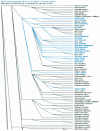MEROPS: the peptidase database
- PMID: 14681384
- PMCID: PMC308805
- DOI: 10.1093/nar/gkh071
MEROPS: the peptidase database
Abstract
Peptidases (proteolytic enzymes) are of great relevance to biology, medicine and biotechnology. This practical importance creates a need for an integrated source of information about them, and also about their natural inhibitors. The MEROPS database (http://merops.sanger.ac.uk) aims to fill this need. The organizational principle of the database is a hierarchical classification in which homologous sets of the proteins of interest are grouped in families and the homologous families are grouped in clans. Each peptidase, family and clan has a unique identifier. The database has recently been expanded to include the protein inhibitors of peptidases, and these are classified in much the same way as the peptidases. Forms of information recently added include new links to other databases, summary alignments for peptidase clans, displays to show the distribution of peptidases and inhibitors among organisms, substrate cleavage sites and indexes for expressed sequence tag libraries containing peptidases. A new way of making hyperlinks to the database has been devised and a BlastP search of our library of peptidase and inhibitor sequences has been added.
Figures



References
-
- Barrett A.J., Rawlings,N.D. and O’Brien,E.A. (2001) The MEROPS database as a protease information system. J. Struct. Biol., 134, 95–102. - PubMed
Publication types
MeSH terms
Substances
LinkOut - more resources
Full Text Sources
Other Literature Sources

